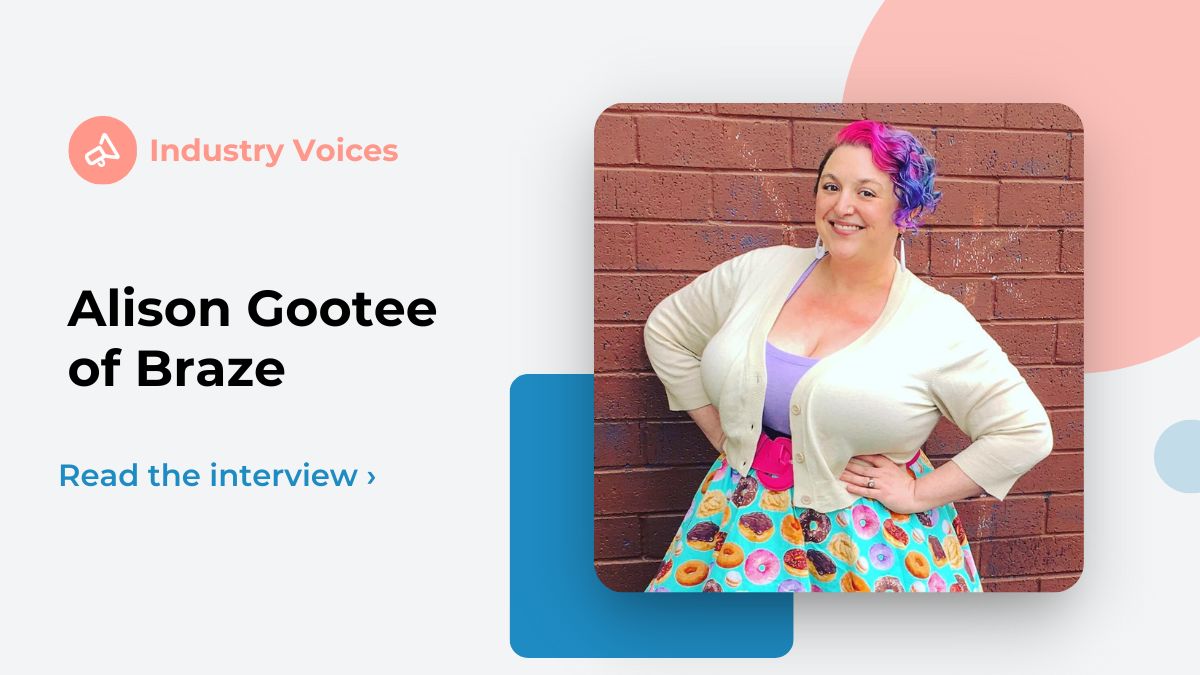
Alison Gootee, Braze: On the Simple Things You Can Do to Win the Email Game
Alison Gootee of Braze talks to ZeroBounce about the Great Gmail Purge, delivery versus email deliverability and winning the email game.
If you’re an email marketer or business owner, chances are you’ve got more than a few doubts about your approach to email.
For instance, you wonder if your list is too small to make an impact. Or maybe you’re not sure if your emails are landing in the inbox. Any uncertainty affects your confidence and possibly your results.
Could it be that a new perspective will steer you in the right direction? Enter email deliverability expert Alison Gootee from Braze, a customer engagement platform. In this interview, Alison talks about:
- Google and Yahoo’s new sending rules
- The bad mindsets that stand between you and your audience
- Why some email newsletters knock it out of the park.
Whether your email list is new or older, small or large, Alison’s insight will give you confidence and push you to try new ideas with your email marketing.
Thank you so much for joining us, Alison. It’s a pleasure to welcome you!
Thank you for having me!
The thing on the lips of every email marketer and email geek is the upcoming Yahoo and Gmail 2024 rules for senders. Is this something to stress over, or is it actually a good thing? Discuss.
Both! Senders who aren’t already meeting these expectations are certainly justified in feeling stressed. There could be heavy lift associated with implementing some of the technical requirements, and there is always a lot of hand-wringing over making it easier to unsubscribe.
Change is hard, and many senders are reluctant to implement updates, whether due to a lack of technical expertise or the potential for disruption to one of their most crucial marketing channels.
From a deliverability standpoint, and as someone who receives a ton of emails, I think it’s great that mailbox providers are raising their standards.
It’s difficult to convince senders to change their practices, so hearing some of these best practices directly from the mailbox providers should go a long way toward reinforcing what many of us have been recommending for years already.
Something thrilling is more people are aware that “deliverability” is more important than delivery. Are enough people aware of the importance of deliverability?
Many senders overestimate their understanding of deliverability and its contributing factors.
As you just alluded to, delivery and deliverability are two separate concepts, and even large brands can confuse them!
For the listeners at home, delivery is when an email is accepted and doesn’t bounce. Deliverability is your ability to actually reach your subscribers’ inboxes, and is typically synonymous with your sender reputation.
Higher sender reputation = better deliverability = more money from your emails because people are actually seeing them.
Senders tend to believe that high delivery must indicate high deliverability, but that’s not the case. As it stands now, mailbox providers don’t actually tell us how much mail has landed in the inbox, but they do let us know when their servers accept a message.
An accepted message could just as easily be in the spam folder, the inbox, or another organizational tab – we just don’t know! To measure your deliverability, you have to look at several factors (like opens, clicks, complaints, conversions, etc.) and make an educated, well-supported guess.
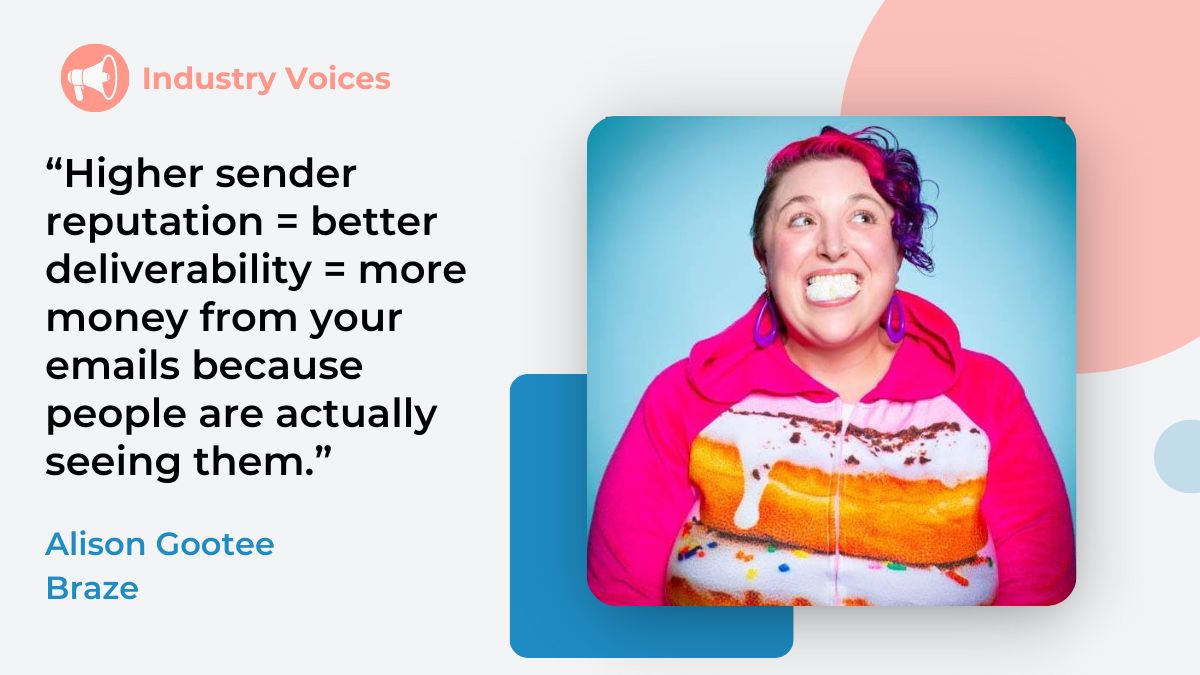
Please blurt out your immediate reaction to the word “spam” in a few words or a line.
Salty! As in, the food that is high in sodium and the irritation I feel when I deal with it.
Related: The Origin of the Word “Spam” – And What Makes an Email Spam
What about “unsubscribe”? Your first thought.
Better than a spam complaint!
What would you say is the best sign that you’re winning the email game? How do you know you’re killing it?
Senders need to define what “winning” is for them! Stop chasing what your competitors are doing and focus on your brand, your audience, and your goals.
For some brands, winning is purely about generating sincere connections with their audience to build brand affinity and retention.
In contrast, others don’t feel victorious unless they have a specific number of subscribers. I firmly support and recommend the first approach, but hey! Some people are satisfied with measuring meaningless numbers.
If your definition of winning is “sending the most emails,” then by all means, send away! In my experience, that isn’t a sustainable plan and will take much more effort than just treating your subscribers like people.
If I were an email marketer myself, I’d be most excited about positive replies, clicks, and (with caveats) purchases. Those behaviors show subscribers are interested in the content and are likely to continue engaging with the mail, which helps ensure messages will reach the inbox in the future. Any action a recipient takes that says, “I like this sender and would be happy to hear from them again,” is a huge win in my book.
Since mailbox providers aren’t measuring revenue generated from emails, I would expend extra effort on crafting content that subscribers actually enjoy receiving instead of sending relentless coupons day after day.
Even if my goal is ultimately to increase revenue, an email subscriber may potentially purchase via social media, app, or elsewhere. So, a lower conversion rate doesn’t necessarily mean the campaign was unsuccessful because subscriber interaction with the email is still valuable.
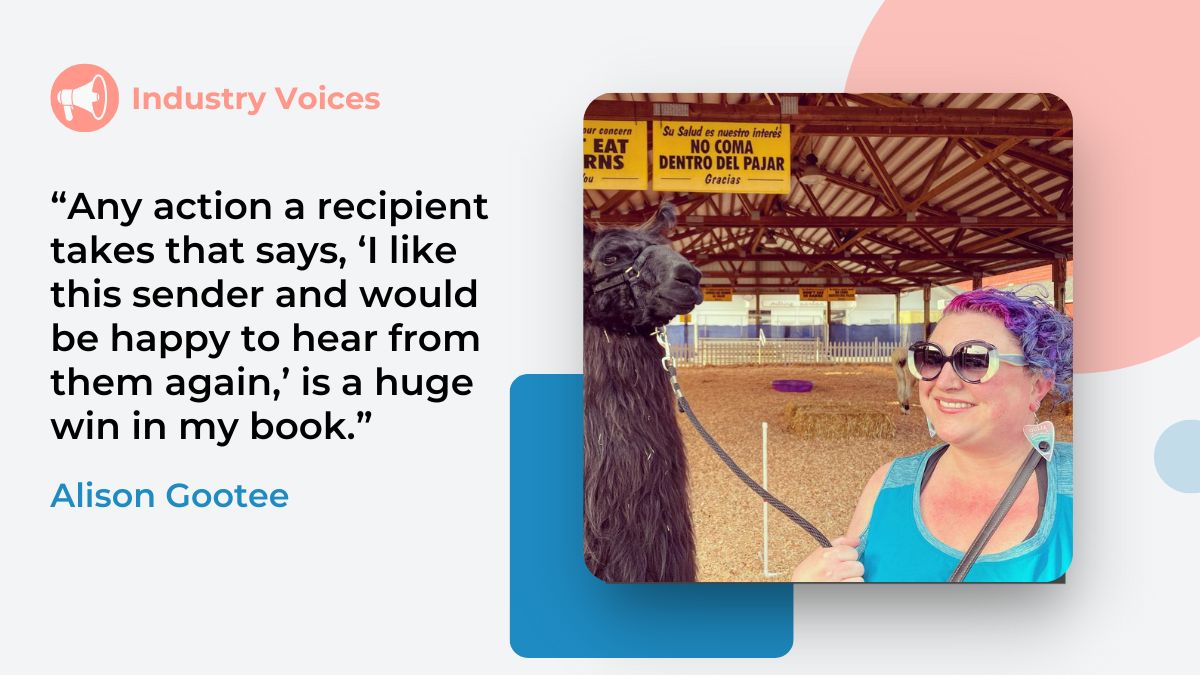
Some people have witnessed really bad email marketing. For example, I’ve been getting emails from a TV personality for some time. But I don’t want the emails anymore! Clicking unsubscribe results in a message that says “not accepting opt-outs.” Do you have any horror stories?
Oof! I hope you reported that message as spam and maybe even contacted the sender’s ESP!
I actually got an email from a company my workplace used for expense reporting about updating their terms and conditions. Since I no longer use the app in any capacity and had even deleted it from my phone, I wanted to unsubscribe – their terms and conditions are irrelevant to me!
There was no unsub option in the email, ostensibly because they considered the message to be transactional. The footer said that I needed to log in to my account… on an app I no longer use to unsubscribe.
I emailed their customer service to suggest they include an unsubscribe link or target their active app users, but they declined. They promised to unsubscribe me, but guess what! I still got an email the next time they updated their policies. And that email, my friends, was reported as spam.

Let’s keep it positive, though! Who do you see out there that always knocks their emails out of the park? Why are they good?
This is a bit meta, but I LOVE the emails from Really Good Emails. They aren’t trying too hard to sell me anything; they’re always extremely entertaining, and I feel like the person who writes them is my friend, even though we’ve never met.
I reply to them ALL THE TIME because they’re so funny, they always use prompts that make me want to respond, and they always write back to me, too!
That’s how email should be; it isn’t a one-way broadcast but a back-and-forth conversation.
Related: Read our interview with Matthew Smith of Really Good Emails
Some email marketers don’t quite grasp that people are expecting more personalization. Why is personalization important, and how can someone get the ball rolling?
Great question!
It often seems like marketers think “personalization” means inserting a first name into the subject line or body and calling it good.
Let’s look at RGE’s emails, which I mentioned a couple of minutes ago. I feel like their emails are personalized without even using my name or saying anything about me specifically because they’re so well-written.
Sometimes a personalized message is just one that feels intimate, even if it was sent to thousands or millions of other people, because a brand has such a great grasp on their customers’ preferences.
If consumers are going to spend their time and money with a brand, they want to feel important. No one enjoys being treated like an ATM where you insert emails and get out cash; we want to believe that brands appreciate our loyalty and will put in effort to retain us.
If you’re struggling with personalizing campaigns for your audience, look at what you already know about them:
- What have they responded well to in the past, and what were they less enthused by?
- How can you give them more of what they liked and less of what they didn’t?
- How can you segment your audience to achieve your goals better and make your customers happy in the process?
All of those things are fairly low-tech, requiring only a legitimate desire to understand your audience and what they actually want.
Should cold emailers be as concerned with email deliverability as the peeps sending marketing emails to opt-in contacts?
Ugh, cold email. Those senders should be the most concerned of all, even if it is technically legal in the US to send unsolicited mail. I understand that many sales-focused organizations rely on it and say it works.
Still, I personally have never responded positively to cold outreach sent to my work address, no matter how relevant (and they almost never are), and I don’t know anyone who has. Even mail sent on a one-to-one basis can hurt your reputation if it gets reported as spam or otherwise engaged with negatively.
I have seen many senders suffer from a degraded reputation due to their sales teams’ cold outreach (especially at Gmail), and it can take months to recover.
The risk isn’t worth it; use other channels and leave folks’ inboxes alone.
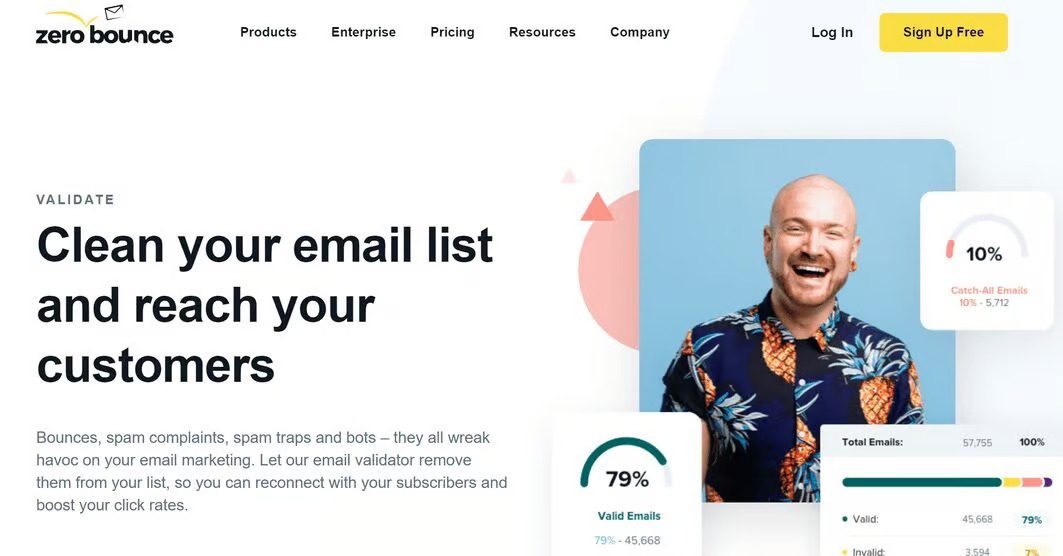
I talked to someone who said they’d been collecting email addresses over the last six months but hadn’t sent anything yet because they wanted to wait until their list grew larger. How would you gently approach that mindset?
Ah yeah, the old “bigger is better” myth, with a dash of list hygiene cluelessness for good measure!
This would be a good time to revisit their goals, and educate them about how deliverability actually works. If their goal is just to have a large list, there’s really no reason to wait for that to happen before starting to send!
List growth can come from existing subscribers helping spread the word, so I would try to frame sending email now as a path towards a larger list in the future instead of a hurdle to overcome.
Regarding list collection, addresses (and the permission to send to them) can grow stale in as little as three to six months without engagement. They’re bread, not wine! The longer they sit without being contacted, the higher the risk that the mailboxes will be full or abandoned. Or there’s always a chance that their owners won’t remember signing up.
To retain as many list members as possible, senders should send a welcome email soon after signup. Be transparent about how often recipients can expect to receive ongoing messages.
Considering the list is already up to six months old, time is of the essence.
They could leverage a service (such as ZeroBounce!) to ensure the list is as clean as possible and then attempt some small-volume sends to test for viability.
If subscribers don’t appear to be interested, then it may be best to switch to a different channel and work on rebuilding from scratch, after having implemented some of the lessons from this exercise.
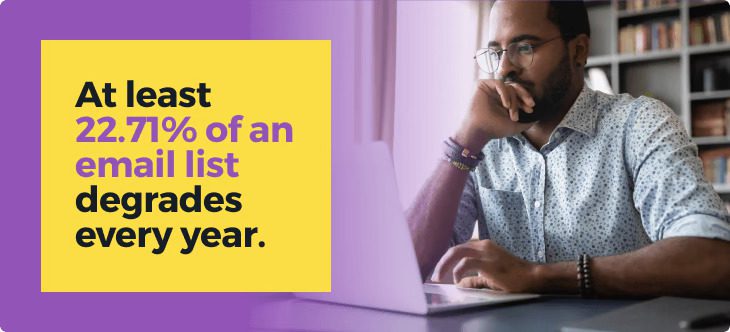
Rapid-fire Q&A with Alison Gootee
Can you recall your first email address? Share it if you dare.
My VERY first email address was on the Prodigy online service. It could only be used internally and didn’t need a domain, just a username. Back then, you couldn’t even pick your own username. So I was HRMX20C (my Dad and Mom being the “A” and “B” accounts, respectively).
Chat didn’t exist yet, so email was the only way to message people privately. I remember my Dad yelling at me because I had gone over our email allotment. So our Prodigy bill was super high one month. As I recall, I was chatting with a cute boy in California. He mailed me his school photo because scanners and digital cameras weren’t household items yet. If you’re out there, I hope you’re doing well, Dave Harris!
If you could email any person in the world, who would it be?
The Gmail postmaster.
Have you ever hit inbox zero? Ever dreamed about it?
Probably back in 1995, and I’ve dreamt about it ever since!
What’s a word or phrase email marketers should use more?
“Do you want to receive my emails?” and they should mean it.
What do you want them to stop saying?
“We collect consent when users agree to our terms and conditions.”
What’s more productive, the office or right at home?
Home all the way! I don’t operate well under restrictive conditions like “show up fully dressed” and “share a bathroom with other people.”
What is the best email you ever got?
The one asking me to do this interview, obviously. Well, that, and the shipping notification for this floral jumpsuit I just got.
Connect with Alison Gootee on LinkedIn.
Table of Contents
- Thank you so much for joining us, Alison. It’s a pleasure to welcome you!
- The thing on the lips of every email marketer and email geek is the upcoming Yahoo and Gmail 2024 rules for senders. Is this something to stress over, or is it actually a good thing? Discuss.
- Something thrilling is more people are aware that "deliverability" is more important than delivery. Are enough people aware of the importance of deliverability?
- Please blurt out your immediate reaction to the word “spam” in a few words or a line.
- What about “unsubscribe”? Your first thought.
- What would you say is the best sign that you’re winning the email game? How do you know you’re killing it?
- Some people have witnessed really bad email marketing. For example, I’ve been getting emails from a TV personality for some time. But I don’t want the emails anymore! Clicking unsubscribe results in a message that says “not accepting opt-outs.” Do you have any horror stories?
- Let’s keep it positive, though! Who do you see out there that always knocks their emails out of the park? Why are they good?
- Some email marketers don’t quite grasp that people are expecting more personalization. Why is personalization important, and how can someone get the ball rolling?
- Should cold emailers be as concerned with email deliverability as the peeps sending marketing emails to opt-in contacts?
- I talked to someone who said they’d been collecting email addresses over the last six months but hadn’t sent anything yet because they wanted to wait until their list grew larger. How would you gently approach that mindset?
- Rapid-fire Q&A with Alison Gootee






